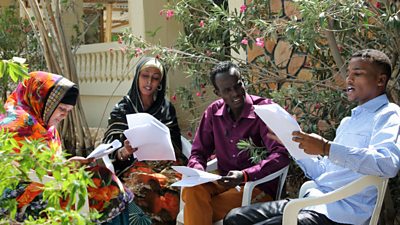Downloads
If youth problems are spoken about, and the ideas are brought together that will make it possible to be released by the media and that would be beneficial.
�������� Media Action was contracted by the Somalia Stability Fund to support the development of the media sector in Somalia - especially its responsiveness to the needs of youth. Formative research highlighted the shared concerns of Somalia’s youth and their aspirations for the future to inform the production of an interactive drama and radio phone-in.
Publication date: April 2015
Context
Although youth is the biggest segment of the population in Somalia, they are marginalised and excluded from decision making on family, community and national issues. This combined with high unemployment rates and low school enrolment rates means that Somalia has an extremely high proportion of disenfranchised youth. However, youth are potentially key agents of positive change as they will lead tomorrow’s Somalia.
While Somalia as a whole still faces significant challenges, it is currently undergoing a period of political development which will potentially lead to greater peace and stability. There is, therefore, a great opportunity in the current climate for initiatives that increase awareness and knowledge of social and community issues affecting youth, with a view to promoting tolerance of diversity and coexistence.
The project
�������� Media Action was contracted by the Somalia Stability Fund to support the development of an audience responsive media sector across Somalia - and to contribute to an understanding of citizenship and identity, particularly amongst youth, through drama programming.
Formative research informed the production of a weekly youth-driven Somali-language radio drama programme (A Better Life than Today), which sees key characters grappling with many of the same issues that Somali youth face. The programme is linked to a discussion programme to help young people talk about these issues as well as some of the opportunities in front of them.
A large component of this project is capacity strengthening of partner radio stations to bring youth issues into their programming - as well as building their skills in audience responsive programming.
Research methodology
Formative research was carried out in August 2014 to better understand our target audiences and tailor the project and programming to their needs. Eighteen focus group discussions were held with urban and rural youth, as well as nine in-depth interviews with youth leaders and media experts, in the different Somali regions.
The study sought to understand which key social issues youth from the different regions of Somalia were concerned with, value, or are interested in. It also examined Somali youth media preferences and the extent to which the media in Somalia responded to the needs of its youth audiences.
Findings
- Participants described Somali youth as being physically fit, strong, energetic and in the prime of their lives - putting them in an ideal position to contribute to the current and future development of their country.
- But, youth feel frustrated at not always being given the chance to contribute to their communities by elders who perceive them to be inexperienced.
- Despite regional differences, Somalia’s youth recognise that have many things in common, including the Muslim religion, Somali language, tradition and oral culture, and social values and characteristics.
- Common concerns of youth across the regions include lack of access to, and poor quality, of education, unemployment, health, illegal migration (‘jumping to the ocean’) and lack of opportunities to participate in politics and governance. Insecurity and conflict was a key concern in South-Central Somalia but less so elsewhere. Females were particularly concerned about rape and its physical, psychological and social consequences.
- Youth were critical of the media, saying that standards of media professionalism are low and that youth issues are not sufficiently tackled.
- Participants said that ideal programmes for youth should be participatory, interactive, cover youth issues, involve specialists and experts, be creative, entertaining, showcase the commonalities of youth across regions, have a broad international scope and be long-lasting with a sustainable impact.
Implications
Youth define themselves in a very positive light and are discouraged that society does not see them in the same way. Thus, radio programming should talk to the positive self-perception of the country’s youth by showing energetic, decisive, proud and active characters in storylines and in interviews.The programmes should also motivate youth by providing them with role models and stories of success that will inspire and encourage them and by addressing youth concerns in the constructive light of ‘what can be done to overcome the barriers’, rather than ‘how awful reality is’.
Media can also empower Somali youth by establishing social networks and platforms through which youth across Somalia can exchange views and ideas, collaborate and motivate each other to act together to make a difference. Importantly, Somali media should take responsibility for bringing pressing social issues and, in particular, the key problems youth are coping with to the forefront of public and government agendas in Somalia.
